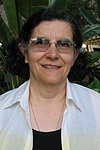Review marathon — a job well done
 |
|
Vaia Papadimitriou
|
Vaia Papadimitriou, associate head of the Accelerator Division and LBNF Beamline manager, wrote this column.
The LBNF beamline (see figure below) will be located at Fermilab and will aim a wide-band neutrino beam toward the DUNE underground detectors placed at the Sanford Underground Research Facility in South Dakota.
The initial proton beam power is expected to be 1.2 megawatts, to be provided by the proposed PIP-II accelerator complex upgrades. The beamline facility is also designed to be upgradeable to 2.4 megawatts, to be provided by the proposed PIP-III. This will enable DUNE, Fermilab's future flagship experiment, to carry out a compelling research program in neutrino physics at much higher beam power than any other operating accelerator-based neutrino experiment in the world.
Although over 75 percent of the 60-plus person Beamline team is based in the Accelerator Division, the team draws colleagues from almost every division and section at Fermilab, as well as from other national institutions, such as Brookhaven National Laboratory, Northwestern University, University of Texas at Arlington, and international collaborating institutions, including CERN and Rutherford Appleton Laboratory, and contractors. We have scientists, engineers, physicists, designers, technicians, environment, health and safety specialists, alignment specialists, project controls specialists, fabrication specialists, procurement specialists — the list goes on and on.
During the past two years the LBNF Beamline team went through six technical design reviews, a comprehensive independent design review for the entire beamline, and three Critical Decision 1 (CD-1) related design and cost/schedule reviews. This is a marathon to run, but last month, we successfully crossed the finish line!
The reviewers were very complimentary of the team. The DOE CD-1 Refresh Review Committee commented on July 16 that they were "impressed by the quality and depth of the presentations," that "the beamline design team is highly qualified and was well prepared," and that many in the team "have worked on the previous neutrino beam lines and bring that world-leading experience to the table." The Committee also found that "the design is very mature, being based on five years of previous work form LBNE and LBNO, and is well beyond the CD-1 level in most instances."
I would like to thank the colleagues who assist in leading this outstanding team, in particular for all their efforts that enabled us to go successfully through this review marathon, namely, the Accelerator Division's Beamline Project Engineer Salman Tariq, Technical Advisor Jim Hylen, Chief Electrical Engineer George Krafczyk, L3 Leaders Rich Andrews, Tom Kobilarcik, Craig Moore, Phil Schlabach, and the Neutrino Division's Alberto Marchionni.
The LBNF Beamline Project would not be possible without the hard work from many colleagues in the Accelerator, Neutrino, Particle Physics and Technical divisions, the Computing Sector, the FESS and ESH&Q sections, the collaborating Institutions and contractors, the DUNE Beam Simulation Group, the Beamline Technical Board and the LBNF Project Office.
I congratulate and thank the entire Beamline team and each colleague separately for everybody's continued excellent work and dedication, which led to such an outstanding performance during the CD-1 Refresh Review. We are now ready for the next challenge in the design phase of the LBNF Beamline and look forward to designing and building it, working together with all our international partners.
 |
This illustration shows the longitudinal section of the LBNF beamline facility at Fermilab. The beam comes from the right, where protons are extracted from the MI-10 straight section of the Main Injector. |
|